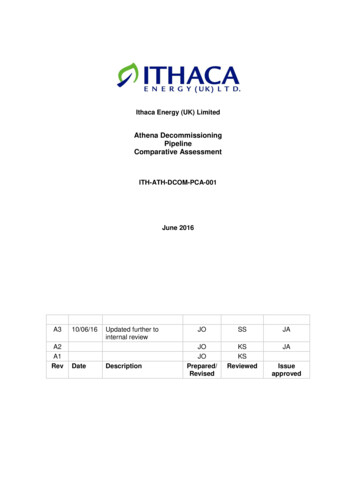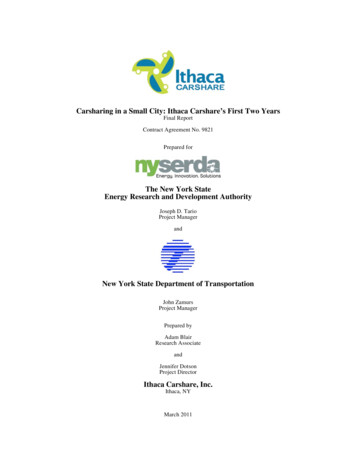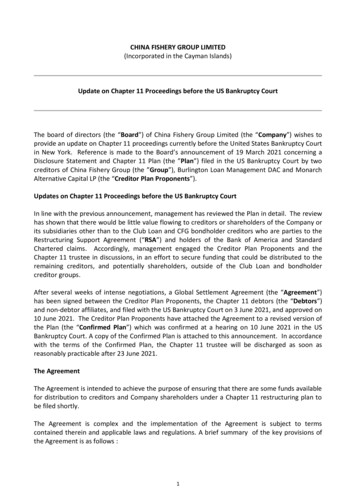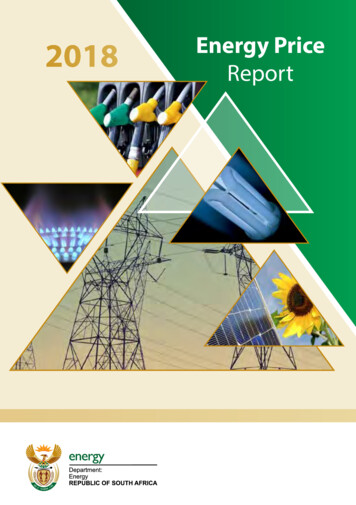
Transcription
Ithaca Energy (UK) LimitedAthena DecommissioningPipelineComparative AssessmentITH-ATH-DCOM-PCA-001June 2016A3A2A1Rev10/06/16DateUpdated further tointernal iewedJAIssueapproved
Athena DecommissioningPipeline Comparative AssessmentIthaca Energy (UK) LimitedMarch 2016Page 1CONTENTS1Introduction and background . 21.1Location of the Athena facilities. 21.2Purpose, Regulatory Context and Approach . 42summary of Environmental conditions . 53Athena Pipeline Facilities for Decommissioning . 84Athena pipeline Decommissioning Options . 185Comparative Assessment process . 185.1Comparative Assessment Criteria and Scoring . 185.2Comparative Assessment Workshop . 246Results and Recommended Options for Athena pipelines Decommissioning . 257Conclusions and Key points . 318Abbreviations and glossary . 329References . 33Appendix A - Pipelines Comparative Assessment Scored Options Matrix . 34
Athena DecommissioningPipeline Comparative Assessment1Ithaca Energy (UK) LimitedMarch 2016Page 2INTRODUCTION AND BACKGROUNDIthaca Energy (UK) Limited (Ithaca) is planning for the decommissioning of the Athena Fieldwhich has been producing since May 2012 and has now ceased production.Ithaca has commenced the update and revision of their Decommissioning Programmes forthose Athena facilities for which they have liability, namely:1. Five Athena wells (4 x production, 1 x water injection)2. All subsea infrastructure associated with the Athena field, including productionmanifold structure, riser base, mid-water arch (MWA) and MWA base, FPSO anchorsystem and associated suction cans and protective material (mattresses and rock)3. All pipelines, flowlines and umbilicals.To fulfil Ithaca’s HS&E policy and in line with regulator guidance, the DecommissioningProgrammes for the Athena Field offshore facilities are supported by a ComparativeAssessment of all feasible options for the decommissioning of the Athena pipelines, risers,umbilicals and associated subsea infrastructure. The Comparative Assessment is asystematic process by which the various options are examined leading to the identification ofa preferred option for decommissioning this infrastructure.1.1Location of the Athena facilitiesThe Athena field is located in the central North Sea, UKCS Block 14/18b, approximately 116km from Fraserburgh on the east Scottish coast and 119km from the UK/Norway median linewith a water depth of approximately 130 m (Figure 1-1)
Athena DecommissioningPipeline Comparative AssessmentIthaca Energy (UK) LimitedMarch 2016Page 3Figure 1.1 Location of Athena fieldThe Athena subsea production pipeline system was tied-back to the BW Athena FPSO(which has now left the field) through an arrangement of wells, subsea manifold, riser basestructure, dynamic risers and umbilicals. The wells are approximately 2 km north east of theBW Athena. The field layout is illustrated in Figure 1-2.
Athena DecommissioningPipeline Comparative AssessmentIthaca Energy (UK) LimitedMarch 2016Page 4Figure 1-2 Field Layout1.2Purpose, Regulatory Context and ApproachThe OSPAR Decision 98/3 on the Disposal of Disused Offshore Installations sets outOSPAR Contracting Parties obligations on the decommissioning of offshore installations.Pipelines are not covered by this OSPAR Decision and there are no international guidelineson the decommissioning of disused pipelines.In the UK, the principal legislation for the decommissioning of disused offshore installationsand pipelines is the Petroleum Act 1998 (as amended) (“the 1998 Act”). Under Part IV of the1998 Act and amendments to this Part of the Act through the Energy Act 2008 (asamended), operators proposing to decommission an offshore installation or submarinepipeline must submit a Decommissioning Programme. Where the programme includes thedecommissioning of pipelines (and cables), Department of Energy and Climate Change(DECC) guidance (DECC 2011) indicates a Comparative Assessment must be carried out toexamine all feasible options for decommissioning to inform decisions relating to thedecommissioning of those pipelines.These options are also the subject of an Environmental Impact Assessment, information andconclusions from which support the Comparative Assessment process.Both theEnvironmental Statement (output from the EIA) and the Comparative Assessment supportthe final Decommissioning Programme, and DECC take these into consideration whenassessing the final Programme for approvalThe decommissioning options considered in the Comparative Assessment for the Athenapipelines, risers, umbilicals and associated infrastructure primarily relate to whether theseare wholly or partially to be left in situ, or fully retrieved, the methods used and their potentialeffects, and any proposed remediation. Consistent with the DECC guidance (DECC 2011),the Comparative Assessment considers these options for the Athena pipelines and risers etc
Athena DecommissioningPipeline Comparative AssessmentIthaca Energy (UK) LimitedMarch 2016Page 5based on the following 5 criteria: Safety, Environmental, Technical, Societal and Economic(see Section 5)This document describes the Comparative Assessment process, the outcomes and therecommended options for the decommissioning of the Athena pipelines, risers andumbilicals.2SUMMARY OF ENVIRONMENTAL CONDITIONSThe water depth at the location is some 130m. The seabed of the Athena field is relativelyflat, becoming slightly shallower to the southwest. Sediments are predominantly sandy mud.Shallow pockmarks are present throughout the development area, although seabedinvestigations have not found them to contain features of special conservation interest.The water mass in the area is derived from oceanic waters entering the North Sea from thenorth to the east of Shetland, and from the northwest through the Fair Isle current. Thewater column stratifies thermally in summer, and surface currents are dominated by weaktides flowing on a predominantly north-south axis. The climate is generally mild for thelatitude, with strongest winds and largest waves occurring during winter months.The seabed animals present are typical for muddy sediments in the central-northern NorthSea, and several species of commercially important fish and shellfish species use the areaas spawning and/or nursery grounds. These include whiting, Norway pout, sprat, bluewhiting and the prawn Nephrops.Harbour porpoise, white-beaked dolphin and minke whale are the most frequently occurringmarine mammals in the wider area, and may occasionally be present in the Athena area.Harbour and grey seals are likely to be present in only limited numbers and for fairly shortperiods. Vulnerable concentrations of seabirds may be present in the Athena area duringJuly-August as birds disperse into the North Sea from their breeding colonies, particularlyaggregations of flightless, moulting adult and juvenile auks.The Athena development lies on the western edge of a large area with numerous oil and gasfields. The Athena field is on the western edge of the Fladen Ground, an area of importancefor commercial fisheries, particularly Scottish demersal trawlers targeting the prawnNephrops and white fish.The main environmental features of the area are shown graphically overleaf.
Athena DecommissioningPipeline Comparative AssessmentIthaca Energy (UK) LimitedMarch 2016Page 6Figure 2.1 Fish spawning regions in the areaFigure 2.2 Fish nursery regions in the area
Athena DecommissioningPipeline Comparative AssessmentIthaca Energy (UK) LimitedMarch 2016Page 7Figure 2.3 Nephrops spawning regions in areaFigure 2.4 Overall seabird vulnerability Index Scores
Athena DecommissioningPipeline Comparative AssessmentIthaca Energy (UK) LimitedMarch 2016Page 8There are a number of Special Protection Areas and Special Areas of Conservation (Natura2000 Sites) on the coasts adjacent (albeit 116km distant) to the Athena field. Similarly, theclosest offshore conservation sites to the field are the Scanner pockmark and Braemarpockmarks (candidate Special Areas of Conservation) some 89km to the east and 130km tothe northeast respectively, (see figure 4)Figure 2.5 Internationally important conservation sites3ATHENA PIPELINE FACILITIES FOR DECOMMISSIONINGThe following section provides an overview of the pipelines, umbilicals and risers (andassociated infrastructure) relevant to the Athena Field Decommissioning Programmescovered by the Comparative Assessment, and the possible options under consideration fortheir removal (Figure 3.1 and Table 3.1). Subsea pipeline stabilisation features are detailedin Table 3.2
Athena DecommissioningPipeline Comparative AssessmentIthaca Energy (UK) LimitedMarch 2016Page 9Figure 3.1 Athena Subsea InfrastructureAll Athena subsea infrastructure was installed in 2011, details as follows: Athena production pipelines (PL2818): the 2.28km 8” diameter production pipeline(PL2818) connects the Athena production manifold to the Athena STP buoy, via theriser base. The production pipeline is trenched and buried from the productionmanifold to the riser base and exposed along the riser length of the pipeline, from theriser base to the STP buoy. Pipeline 2818 is no longer in use and has been cleanedand is currently filled with inhibited seawater.Athena water injection pipelines (PL2819) the 2.28km, 8″ diameter infield waterinjection pipeline (PL2819) connects the Athena production manifold to the AthenaSTP buoy, via the riser base. The water injection pipeline is trenched and buried fromthe production manifold to the riser base and exposed along the riser length of thepipeline, from the riser base to the STP buoy. Pipeline PL2818 is no longer in useand is currently filled with inhibited seawater.Athena service line (PL2820): the 2.28km follows the same route as the productionand water injection pipelines (see above). It is a 3” diameter line and is no longer inuse, has been cleaned and filled with inhibited seawater.Athena ESP Power Cable (PLU2821): The 2.28km 8” ESP power cable runs fromthe production manifold to the STP Buoy. It is a combined static to dynamic umbilical(via a transition bulkhead at the riser base). The cable is trenched (static) betweenthe production manifold and riser base and exposed (dynamic) from the riser base tothe STP buoy. It is currently isolated.Athena EHC Umbilical (PLU2822): The 2.28km 8” EHC umbilical runs from theproduction manifold to the STP Buoy. It is a combined static to dynamic umbilical (viaa transition bulkhead at the riser base). The cable is trenched (static) between theproduction manifold and riser base and exposed (dynamic) from the riser base to theSTP buoy. The EHC umbilical has been flushed and cleaned and currently contains a50/50 MEG potable water mix.Athena Electric cable bundles (PLU2823, PLU2826, PLU2829, PLU2832 andPLU2835): The electrical cable bundles run from each well (P1 – P4 production wellsand the WI well) to the subsea manifold. The cable bundles are mattressed at the
Athena DecommissioningPipeline Comparative Assessment Ithaca Energy (UK) LimitedMarch 2016Page 10appropriate points and the connections are supported by grout bags. All the bundlesare currently positively isolated.Athena Hydraulic Hose Bundles (PLU2824 PLU2827, PLU2830, PLU2833 andPLU2836): The hydraulic hose bundles also run from each well (P1 – P4 productionwells and the WI well) to the subsea manifold. The hose bundles are mattressed atthe appropriate points and the connections are supported by grout bags. Thehydraulic hoses retain their contents of HW540E water-based hydraulic fluid.Athena Chemical Hose Bundles (PLU2825, PLU2828, PLU2831 and PLU2834):The chemical hose bundles similarly run from each well (P1 – P4 production wellsand the WI well) to the subsea manifold. The hose bundles are mattressed at theappropriate points and the connections are supported by grout bags. The chemicalhose bundles have been flushed and cleaned and currently contain a 50/50 MEGpotable water mix.Seabed deposits Concrete Mattresses: A total of 172 concrete mattresses are located at the riserbase and manifold end of pipelines and between manifold and wells.Sand Bags: A quantity (approximately 400) 10 tonne sandbags are deposited at theproduction manifold for flushing spool support.Grout bags: A number of grout bags were deposited at the riser base, manifold andwell tie-in spools.There are no rock dump deposits within the Athena subsea infrastructure footprint.
Ithaca Energy (UK) LimitedMarch 2016Page 11DecommissioningPipeline Comparative AssessmentTable 3.1: Pipeline/Flowline/Umbilical InformationDescriptionPipelineNumber(as perPWA)Diameter(inches)Length (km)Description ofComponent PartsProductConveyedFrom – ToEnd PointsBurial nePL28188"2.2808” Static FlexibleDuplex carcassPipeline8” Flexible Duplexcarcass RiserOil; GasSubsea ManifoldToSTP BuoyTrenched &Buried withRiserExposed.IPRFlushed 10mg/l OIWTreated seawaterP1 tie-in spoolPL2818JP16”0.060Rigid SpoolSuper duplexOil; GasP1 wellToSubsea ManifoldMattresses.Connectionssupported bygrout bagsIPRFlushed 10mg/l OIWTreated seawaterP2 tie-in spoolPL2818JP26”0.044Rigid SpoolSuper duplexOil; GasP2 wellToSubsea ManifoldMattresses.Connectionssupported bygrout bagsIPRFlushed 10mg/l OIWTreated seawaterP3 tie-in spoolPL2818JP36”0.053Rigid SpoolSuper duplexOil; GasP3 wellToSubsea ManifoldMattresses.Connectionssupported bygrout bagsIPRFlushed 10mg/l OIWTreated seawaterP4 tie-in spoolPL2818JP46”0.042Rigid SpoolSuper duplexOil; GasP4 wellToSubsea ManifoldMattresses.Connectionssupported bygrout bagsIPRFlushed 10mg/l OIWTreated seawater
Ithaca Energy (UK) LimitedMarch 2016Page 12DecommissioningPipeline Comparative AssessmentTable 3.1: Pipeline/Flowline/Umbilical Information (continued)DescriptionPipelineNumber(as perPWA)Diameter(inches)Length (km)Description ofComponent PartsProductConveyedFrom – ToEnd PointsBurial StatusPipelineStatusCurrentContentWaterinjection linePL28198”22808” Static FlexibleDuplex carcassPipeline8” Flexible Duplexcarcass RiserTreated seawater/producedwater reinjectionSubsea ManifoldToSTP BuoyTrenched &Buried withRiserExposedIPRFlushed 10mg/l OIWTreated seawaterWI tie-in spoolPL2819JW16”0.021Super DuplexTreated seawater/producedwater reinjectionWI wellToSubsea ManifoldMattresses.Connectionssupported bygrout bagsIPRFlushed 10mg/l OIWTreated seawater
Ithaca Energy (UK) LimitedMarch 2016Page 13DecommissioningPipeline Comparative AssessmentTable 3.1: Pipeline/Flowline/Umbilical Information (continued)DescriptionPipelineNumber (asper PWA)Diameter(inches)Length (km)Description ofComponent PartsProductConveyedFrom – ToEnd PointsBurial StatusPipelineStatusCurrentContentService linePL28203”22803” Static FlexibleDuplexcarcassPipeline3” Flexible Duplexcarcass RiserTreatedSeawaterSubsea ManifoldToSTP BuoyTrenchedand buriedwith riserExposedIPRFlushed 10mg/l OIWTreatedseawaterP1 service tiein spoolPL2820JP12”0.060Rigid SpoolDuplexTreatedSeawaterP1 wellToSubsea ManifoldMattresses.Connectionssupported bygrout bagsIPRFlushed 10mg/l OIWTreated seawaterP2 service tiein spoolPL2820JP22”0.044Rigid SpoolDuplexTreatedSeawaterP2 wellToSubsea ManifoldMattresses.Connectionssupported bygrout bagsIPRAs aboveP3 service tiein spoolPL2820JP32”0.053Rigid SpoolDuplexTreatedSeawaterP3 wellToSubsea ManifoldMattresses.Connectionssupported bygrout bagsIPRAs aboveP4 service tiein spoolPL2820JP42”0.042Rigid SpoolDuplexTreatedSeawaterP4 wellToSubsea ManifoldMattresses.Connectionssupported bygrout bagsIPRFlushed 10mg/l OIWTreated seawater
Ithaca Energy (UK) LimitedMarch 2016Page 14DecommissioningPipeline Comparative AssessmentTable 3.1: Pipeline/Flowline/Umbilical Information (continued)DescriptionPipelineNumber(as perPWA)Diameter(inches)Length (km)Description ofComponentPartsProductConveyedFrom – ToEnd PointsBurialStatusPipelineStatusCurrentContentESP PowerCablePLU28218”2280Combined staticto dynamicumbilical(via transitionbulkhead)Electric PowerSubsea ManifoldToSTP BuoyTrenchedand buriedwith riserExposedIPRIsolated &positivelydisconnectedP1 tie inJumperPLU2821JP12”0.100FlexibleJumperElectric powerP1 wellToSubsea ManifoldMattresses,grout bags atconnectionsIPRIsolated &positivelydisconnectedP2 tie inJumperPLU2821JP22”0.085FlexibleJumperElectric powerP2 wellToSubsea ManifoldMattresses.Connectionssupported bygrout bagsIPRIsolated &positivelydisconnectedat FPSOP3 tie inJumperPLU2821JP32”0.085FlexibleJumperElectric powerP3 wellToSubsea ManifoldMattresses.Connectionssupported bygrout bagsIPRIsolated &positivelydisconnectedat FPSOP4 tie inJumperPLU2821JP42”0.070FlexibleJumperElectric powerP4 wellToSubsea ManifoldMattresses.Connectionssupported bygrout bagsIPRIsolated &positivelydisconnectedat FPSO
Ithaca Energy (UK) LimitedMarch 2016Page 15DecommissioningPipeline Comparative AssessmentTable 3.1: Pipeline/Flowline/Umbilical Information (continued)DescriptionPipelineNumber(as perPWA)Diameter(inches)Length (km)Description ofComponent PartsProductConveyedFrom – ToEnd PointsBurial StatusPipelineStatusCurrentContentEHC UmbilicalPLU28228”2280Combined staticto dynamicumbilical(via transitionbulkhead)ElectricalPower/Hydraulic Fluid/ChemicalsSubsea ManifoldToSTP BuoyTrenchedand buriedwith riserExposedIPRHW540EWater basedHydraulic, OilFlushed 50/50MEG/PotablewaterElectric cablebundlePLU2823N/A0.100Jumper bundlecontaining 4 xelectric cablesElectric powerP1 wellToSubsea ManifoldMattresses.Connectionssupported bygrout bagsIPRIsolated &positivelydisconnectedat FPSOHydraulichose bundlePLU2824N/A0.100Jumper bundlecontaining 13 xhydraulic hosesHydraulic fluidP1 wellToSubsea ManifoldMattresses.Connectionssupported bygrout bagsIPRRetainHW540EWater basedHydraulic, OilChemicalhose bundlePLU2825N/A0.100Jumper bundlecontaining 2 xchemical hosesChemicalsP1 wellToSubsea ManifoldMattresses.Connectionssupported bygrout bagsIPRFlushed 50/50MEG/PotablewaterElectric cablebundlePLU2826N/A0.85Jumper bundlecontaining 4 xelectric cablesElectric powerP2 wellToSubsea ManifoldMattresses.Connectionssupported bygrout bagsIPRIsolated &positivelydisconnectedat FPSOHydraulichose bundlePLU2827N/A0.085Jumper bundlecontaining 13 xhydraulic hosesHydraulic fluidP2 wellToSubsea ManifoldMattresses.Connectionssupported bygrout bagsIPRRetainHW540EWater basedHydraulic, Oil
Ithaca Energy (UK) LimitedMarch 2016Page 16DecommissioningPipeline Comparative AssessmentTable 3.1: Pipeline/Flowline/Umbilical Information (continued)DescriptionPipelineNumber(as perPWA)Diameter(inches)Length (km)Description ofComponent PartsProductConveyedFrom – ToEnd PointsBurial StatusPipelineStatusCurrentContentChemicalhose bundlePLU2828N/A0.085Jumper bundlecontaining 2 xchemical hosesChemicalsP2 wellToSubsea ManifoldMattresses,grout bags atconnectionsIPRFlushed 50/50MEG/PotablewaterElectric cablebundlePLU2829N/A0.085Jumper bundlecontaining 4 xelectric cablesElectric powerP3 wellToSubsea ManifoldMattresses,grout bags atconnectionsIPRIsolated &positivelydisconnectedHydraulichose bundlePLU2830N/A0.085Jumper bundlecontaining 13 xhydraulic hosesHydraulic fluidP3 wellToSubsea ManifoldMattresses,grout bags atconnectionsIPRRetainHW540EWater basedHydraulic, OilChemicalhose bundlePLU2831N/A0.085Jumper bundlecontaining 2 xchemical hosesChemicalsP3 wellToSubsea ManifoldMattresses,grout bags atconnectionsIPRFlushed 50/50MEG/PotablewaterElectric cablebundlePLU2832N/A0.070Jumper bundlecontaining 4 xelectric cablesElectric powerP4 wellToSubsea ManifoldMattresses.Connectionssupported bygrout bagsIPRIsolated &positivelydisconnectedHydraulichose bundlePLU2833N/A0.070Jumper bundlecontaining 13 xhydraulic hosesHydraulic fluidP4 wellToSubsea ManifoldMattresses.Connectionssupported bygrout bagsIPRRetainHW540EWater basedHydraulic, Oil
Ithaca Energy (UK) LimitedMarch 2016Page 17DecommissioningPipeline Comparative AssessmentTable 3.1: Pipeline/Flowline/Umbilical Information (continued)DescriptionPipelineNumber(as perPWA)Diameter(inches)Length (km)Description ofComponent PartsProductConveyedFrom – ToEnd PointsBurial StatusPipelineStatusCurrentContentChemicalhose bundlePLU2834N/A0.070Jumper bundlecontaining 2 xchemical hosesChemicalsP4 wellToSubsea ManifoldMattresses.Connectionssupported bygrout bagsIPRFlushed 50/50MEG/PotablewaterElectric cablebundlePLU2835N/A0.070Jumper bundlecontaining 3 xelectric cablesElectric powerWI wellToSubsea ManifoldMattresses.Connectionssupported bygrout bagsIPRIsolated &positivelydisconnectedat FPSOHydraulichose bundlePLU2836N/A0.070Jumper bundlecontaining 8 xhydraulic hosesHydraulic fluidWI wellToSubsea ManifoldMattresses.Connectionssupported bygrout bagsIPRRetainHW540EWater basedHydraulic, OilStabilisation FeatureTable 3.2: Subsea Pipeline Stabilisation FeaturesTotal NumberWeight (Te)LocationsConcrete mattresses1721032te6te eachGrout bags1440Sand bags400Exposed/Buried/ConditionAt riser base and manifold end ofpipelines and between manifoldand wellsExposed36te25kg eachAt riser base, manifold and welltie-in spoolsExposed10te25kg eachAt manifold for flushing spoolsupportExposed
Athena DecommissioningPipeline Comparative Assessment4Ithaca Energy (UK) LimitedMarch 2016Page 18ATHENA PIPELINE DECOMMISSIONING OPTIONSIn line with DECC guidance, this Comparative Assessment has been undertaken to informdecisions relating to the decommissioning of the pipelines, umbilicals, risers, and associatedsubsea infrastructure described in Section 3 above and shown in Figure 3.1. The optionsbeing considered by Ithaca are:1. Approach mattresses recovered. Complete recovery of; pipelines and risers, (includingumbilicals) using reverse lay, recovery of riser base, (piles cut and structure removed)manifold (piles cut below mudline and structure removed) mattresses and spools (at drillcentre).2. As option 1 but to include deburial of pipelines should the soil strength be too great topull pipeline through.3. As option 1 but pipelines are cut into discrete lengths and recovered rather than reeled.4. Approach mattresses recovered. Risers (and associated umbilicals) are cut into discretelengths and recovered. Pipeline ends are cut and recovered; remaining ends are loweredinto the seabed below MSBL mudline). Riser base, manifold structure, drill centre spoolsand mattresses are recovered.5. As option 4 but riser base and manifold structure are left in situ and rock dumped.6. As option 5 but risers are left in situ; lowered to seabed and trenched to depth of 0.6m.For the purposes of this comparative assessment, Options 5 and 6 were not taken forwardfor consideration in the comparative assessment workshop. The riser base and productionmanifold are installations that would be required to be removed in accordance with OSPARdecision 98/3 and therefore leaving them in situ would not be in compliance with either theOSPAR decision nor DECC guidance.5COMPARATIVE ASSESSMENT PROCESSIthaca developed a framework for conducting a Comparative Assessment using qualitativeand quantitative data to evaluate the alternative decommissioning options outlined in Section4. This framework draws from OSPAR 98/3 and DECC’s Decommissioning guidance. Amethodology and scoring system was used to assess the relative performance of each of thepotential decommissioning options for the pipelines and power cable, with results presentedin the Matrix in Appendix 1 and discussed in Section 6.5.1Comparative Assessment Criteria and ScoringCriteria for evaluating the relative potential impact/risk of the options were developed withreference to DECC Guidance (DECC alEconomicSub-criteria were then derived (see Table 5.1) to cover:
Athena DecommissioningPipeline Comparative Assessment Ithaca Energy (UK) LimitedMarch 2016Page 19The potential risk to life of offshore and onshore personnel of each option consideredAll potential impacts (including cumulative effects) on the marine environment,including exposure of biota to contaminants, other biological impacts arising fromphysical effects, impacts on mariculture, and interference with other legitimate usesof the seaAll potential impacts on other environmental receptors, including emissions to theatmosphere, leaching to groundwater, discharges to surface fresh water and effectson the soilConsumption of natural resources and energy associated with reuse and recyclingOther consequential effects on the physical environment which may be expected toresult from the selected optionPotential risk of project failure and technical challengePotential impacts on amenities, the activities of communities and on future uses ofthe environmentCosts of each optionThe sub-criteria were scored on a five point scale ranging from 1 (Very Low) through to 5(Very High), where 1 represents best performance/least significant impact/lowest risk and 5worst performance/largest significant impact/highest risk. Scores for the sub-criteria werethen weighted on a three point scale (see Table 5.2) according to the level of definition andunderstanding of methods, equipment and hazards (“uncertainty”), ranging from LowUncertainty – high definition and understanding of methods, equipment and hazards(weighting x 1), to High Uncertainty – low level of definition and understanding of methods,equipment and hazards (weighting x 2). Final scores for each criterion were recorded inmatrix format (see Appendix 1) with relative ranking for each option derived from theweighted scores using the matrix in Table 5.3.Where quantitative data are used, these have been based on measurable data fromsupporting decommissioning studies, i.e. CO2 emissions (tonnes) and cost estimates.Qualitative assessment is based on a range of sources including regional and site specificdata, supporting studies including the Athena Decommissioning EIA, and conducted byexperts with wide experience in the strategic and project level assessment of oil and gasactivities and developments the North Sea.
Ithaca Energy (UK) LimitedMarch 2016Page 20DecommissioningPipeline Comparative AssessmentTable 5.1 – Relative Risk and Impact Criteria and ScoringCriteriaSub criteriaVery lityVery High5SafetyRisk to personnel offshore duringdecommissioning operationsNo riskMinor/first aidMedical aid/lost time injuryMultiplefatalitiesSafetyRisk to personnel onshore duringdecommissioning operationsNo riskMinor/first aidMedical aid/lost time injurySafetyRisk to divers duringdecommissioning operationsNo riskMinor/first aidMedical aid/lost time injurySafetyRisk to 3rd parties and assetsduring decommissioningoperationsNo riskLoss of accessto operationalareaInterferencewith 3rd partyoperationsaltering safetyriskDamage to 3rdpartyasset/damageto vesselDamage to 3rdparty assetrequiringremediation/loss of vesselSafetyResidual risk to 3rd partiesNo riskPotentialsnagging riskDamage/lossof fishing gearDamage tovesselLoss of vesselEnvironmentChemical dischargeNonePLONORchemicals onlyNo warnings orsubstitutionlabels RQ 1Warning labelsRQ 1Warnings andsubstitutionlabels RQ 1EnvironmentHydrocarbon release frompipelinesNone 50 litres50 litres - 500litres501 litres 1000 litres 1000 litresEnvironmentSeabed disturbance and/orhabitat alteration includingcumulative impactNone 10% ofexistingfootprint10% - 50% ofexistingfootprint 50% - 100%of existingfootprint 100% ofexistingfootprintEnvironmentTotal energy consumption andGHG emissions 10,000Gj10,000100,000Gj 100,000200,000Gj 200,000400,000Gj 400,000GjMultiplefatalitiesMultiplefatalities
Ithaca Energy (UK) LimitedMarch 2016Page 21DecommissioningPipeline Comparative AssessmentCriteriaSub criteriaVery Low1Low2Medium3EnvironmentProportion of material recycled 80%50% - 80%30% - 50%EnvironmentProportion of material landfilled0% 10%10% - 30%EnvironmentTechnicalConservation sites and species(including noise effects)Technical feasibilityTechnicalWeather sensitivitySocietalResidual effect on fishing,navigation or other access(including cumulative)Routineoperations withhighconfidence ofoutcomesPotentialeffects butunlikely to bedetectable aswithin normalvariabilityRoutineoperationswith goodconfidence ofoutcomesVery low risk offailureLow risk offailureLow risk offailureOperations notweathersensitiveOperations arelittle affectedby weatherRequires goodweatherwindowNo effectAccess to areaunrestrictedAccess to areawith chartedobstructionsNo impactMinordetectableeffects withrapid recoveryNon-routineoperations butwith goodexperiencebaseHigh410% - 30% 30% - 50%Effectsdetectable, notaffecting siteintegrity orspeciespopulationNon-routineoperations withlimitedexperiencebaseModerate riskof failureRequirestypical summergood weatherwindowAccess to areawith uncharteddebris andobstructionsVery High5 10% 50%Significanteffects on siteintegrity orpopulationUntriedtechniqueHigher risk offailureRequires longgood weatherwindowClosed accessto area
Ithaca Energy (UK) LimitedMarch 2016Page 22DecommissioningPipeline Comparative AssessmentCriteriaSub criteriaVery Low1Low2Impacts withinnormalvariability ofonshoreoperationsMedium3High4Very High5Short termnuisanceduring onshore
Ithaca has commenced the update and revision of their Decommissioning Programmes for those Athena facilities for which they have liability, namely: 1. Five Athena wells (4 x production, 1 x water injection) 2. All subsea infrastructure associated with the Athena field, including production manifold structure, riser base, mid-water arch (MWA .










